The damage and destruction to essential infrastructure in Gaza inflicted by this war in just its first four months is estimated to be worth around USD 18.5 billion
Aims Special Report
The United Nations, the World Bank and the European Union have jointly produced an interim assessment of the devastation in the Gaza Strip.
The report says it will take years to reconstruct and rebuild Gaza, with 26 million tons of debris to take many years to clear. The said report enlighten that Israel has destroyed over 72% of homes in Gaza since October 7. In this joint report released beginning of last month that the damage and destruction to essential infrastructure in Gaza inflicted by this war in just its first four months is estimated to be worth around USD 18.5 billion.
The report, financed by the European Union (EU), and titled the ‘Interim Damage Assessment Note’, states that the destruction in Gaza since October is “unprecedented.”
According to the report, approximately 62% of all homes in Gaza, or 290,820 housing units, have been damaged or destroyed. This has resulted in over a million Palestinians rendered homeless. Damage and destruction to homes and residential buildings alone accounts for 72% of the total damage costs, at an estimated value of USD 13.3 billion.
The Gaza Strip Interim Damage Assessment was conducted by the World Bank, the European Union (EU), and the United Nations (UN). The findings, interpretations, and conclusions expressed in this work do not necessarily reflect the views of the World Bank, its Board of Executive Directors, or the governments they represent, or those of the EU or UN. The World Bank, EU and UN do not guarantee the accuracy of the data included in this work and accept no responsibility or liability for any omissions or errors (including, without limitation, typographical errors and technical errors) in the content whatsoever or for reliance thereon. The boundaries, colours, denominations, and other information shown on any map in this work do not imply any judgment on the part of the World Bank concerning the legal status of any territory or the endorsement or acceptance of such boundaries.

Rights and Permissions
The material in this work is subject to copyright. Because the World Bank, the EU and the UN encourage dissemination of their knowledge, this work may be reproduced, in whole or in part, for non-commercial purposes if full attribution to this work is given and all further permissions that may be required for such use (as noted herein) are acquired. The content of this work does not infringe on the rights of third parties and as such the World Bank, EU, and UN accept no responsibility or liability in this regard.
Disclaimer
This interim damage assessment note provides a preliminary estimate of the impact of the ongoing conflict in the Gaza Strip up to the end of January 2024. It depicts a mapping of the Gaza Strip with an estimate of the cumulative damage for critical sectors, expressed in both physical and monetary terms, along with an initial assessment of the human and social impacts. Current sectors being assessed include Housing, Health, Education, Cultural Heritage, Water, Sanitation and Hygiene (WASH), Energy, Transport, Information and Communication Technology (ICT), Municipal Services, Commerce, Industry, and Services, Finance, and Agriculture. The assessment also includes cross-sectoral themes, such as social and environmental impacts and an overall macro-economic impact assessment. While the physical and economic impact assessments are based on data mostly covering the period of October 7, 2023, to January 26, 2024, figures related to the casualties and human impact are current to March 14, 2024.

1. Executive Summary
The ongoing conflict in the Gaza Strip has caused loss of life, forced displacement, and damages to social, physical, and productive infrastructure at an unprecedented speed and scale. The United Nations (UN), European Union (EU) and other humanitarian and development partners have repeatedly called it an extremely severe humanitarian crisis.1 While physical destruction in Gaza is severe in every sector of the economy, the housing sector and population centres have sustained the majority of damages. As of end of January 2024, direct damage of around US$18.5 billion has been inflicted on the built infrastructure of Gaza, equivalent to 97% of the total Gross Domestic Product (GDP) of West Bank & Gaza in 2022. Over four fifths of damages are concentrated in the two sectors of residential buildings (72% of the total) and the commerce, industry, and services sector (9% of the total) with the remaining 19% of damages sustained on other critical infrastructure and services such as education, water, sanitation and hygiene (WASH), health, energy, Information and Communication Technology (ICT), municipal services, and transport. Nearly 80% of total damage occurred in the governorates of Gaza, North Gaza, and Khan Younis. The conflict has caused an unprecedented and rapidly deteriorating humanitarian crisis in Gaza. 2 As of March 14, reportedly more than 31,000 people have been killed in Gaza of which approximately 70% are women and children; 1.7 million people have been displaced. 3 According to projections from the latest Integrated Food Security Phase Classification (IPC) food insecurity classification, more than half the population of Gaza is on the brink of famine and the entire population is experiencing acute food insecurity and malnutrition. 4 Palestinians in Gaza now make up 80 percent of all people facing famine or severe hunger worldwide.5 Palestinians in Gaza are receiving less than half the daily water rations they need for shortterm emergency survival6 and further reductions are likely as fuel supplies dwindle. More than 1 million people have lost their homes.7 Health service delivery is experiencing major disruptions as nearly 84% of health facility buildings have been destroyed or damaged and those remaining lack access to medicines, ambulances, basic lifesaving treatments, electricity and water. The education system has completely collapsed, with all children out of school and most schools being used as shelter for internally displaced people (IDP). An estimated 17,000 children have been separated from their families,8 rendering them particularly vulnerable to various forms of exploitation and abuse. Owing to pervasive trauma linked to the ongoing violence mental health has deteriorated severely especially among the vulnerable including women, children, the elderly, and persons with disabilities.
European Union (EU) and other humanitarian and development partners have repeatedly called it an extremely severe humanitarian crisis.1 While physical destruction in Gaza is severe in every sector of the economy, the housing sector and population centres have sustained most damages. As of end of January 2024, direct damage of around US$18.5 billion has been inflicted on the built infrastructure of Gaza, equivalent to 97% of the total Gross Domestic Product (GDP) of West Bank & Gaza in 2022. Over four fifths of damages are concentrated in the two sectors of residential buildings (72% of the total) and the commerce, industry, and services sector (9% of the total) with the remaining 19% of damages sustained on other critical infrastructure and services such as education, water, sanitation and hygiene (WASH), health, energy, Information and Communication Technology (ICT), municipal services, and transport. Nearly 80% of total damage occurred in the governorates of Gaza, North Gaza, and Khan Younis. The conflict has caused an unprecedented and rapidly deteriorating humanitarian crisis in Gaza.2 As of March 14, reportedly more than 31,000 people have been killed in Gaza of which approximately 70% are women and children; 1.7 million people have been displaced.3 According to projections from the latest Integrated Food Security Phase Classification (IPC) food insecurity classification, more than half the population of Gaza is on the brink of famine and the entire population is experiencing acute food insecurity and malnutrition.4 Palestinians in Gaza now make up 80 percent of all people facing famine or severe hunger worldwide.5 Palestinians in Gaza are receiving less than half the daily water rations they need for shortterm emergency survival6 and further reductions are likely as fuel supplies dwindle. More than 1 million people have lost their homes.7 Health service delivery is experiencing major disruptions as nearly 84% of health facility buildings have been destroyed or damaged and those remaining lack access to medicines, ambulances, basic lifesaving treatments, electricity and water. The education system has completely collapsed, with all children out of school and most schools being used as shelter for internally displaced people (IDP). An estimated 17,000 children have been separated from their families,8 rendering them particularly vulnerable to various forms of exploitation and abuse. Owing to pervasive trauma linked to the ongoing violence mental health has deteriorated severely especially among the vulnerable including women, children, the elderly, and persons with disabilities.
Palestinians in the Gaza Strip and the West Bank, including East Jerusalem, and requests US$1.23 billion to meet critical needs of 2.7 million people (2.2 million in the Gaza Strip and 500,000 in the West Bank, including East Jerusalem). As of February 26, 2024, member states disbursed nearly US$907 million against the Appeal (74 per cent). Additional details are available through the Flash Appeal Financial Tracking dashboard. Member states are strongly encouraged to provide additional funding to the humanitarian system supporting operations in Gaza and the West Bank, including East Jerusalem, given the unprecedented scale and intensity of the crisis. Supporting the humanitarian response must be a strong focus of the international community for the foreseeable future. However, in parallel, it will be also critical to undertake timely planning and preparation for the recovery, in order to be ready for implementation as soon as conditions on the ground permit. The World Bank, EU, and UN have conducted the Interim Damage Assessment, the results of which are presented in this report, to provide a comprehensive preliminary analysis of the damages from the conflict to date and their human and economic impacts. While reports have highlighted the extensive scale of the crisis and its human and socio-economic impact,19 this report provides a comprehensive analysis of the unprecedented scale of destruction in terms of infrastructure, productive assets, and service delivery, linking them to the overall human and economic impacts. The purpose of the assessment is to inform national stakeholders and the international community of the preliminary extent of damage caused by the conflict both in physical and monetary terms, to serve as a ready basis for supporting and facilitating the forthcoming RDNA as well as the subsequent process of developing a roadmap for recovery. This exercise also supports the goals of the partners and the international community of remaining engaged during conflict and crisis situations, and to provide financing and analytical support in contexts affected by fragility, conflict, and violence.20 This interim damage assessment provides a preliminary estimate of the impact of the ongoing conflict in the Gaza Strip up to the end of January 2024. It depicts a mapping of the Gaza Strip with an estimate of the cumulative infrastructure damages21 for critical sectors, expressed in both physical and monetary terms, along with an initial assessment of the human and social impacts. Current sectors being assessed include Housing, Health, Education, Cultural Heritage, WASH, Energy, Transport, ICT, Municipal Services, Commerce, Industry, and Services, Finance, and Agriculture. The assessment also includes cross-sectoral themes, such as social and environmental impacts, and an overall macro-economic impact assessment. While the physical and economic impact assessments are based on data mostly covering the period of October 7, 2023, to January 26, 2024, figures related to the casualties and human impact are current to March 14, 2024. This interim damage assessment is not a full-fledged Rapid Damage and Needs Assessment (RDNA), which will be carried out when the situation permits. The subsequent RDNA will, in addition to the physical and monetary damages estimated in this interim assessment, include the economic and social losses incurred because of the conflict, as well as the needs and costs associated with the restoration of service delivery and recovery and reconstruction across a broader array of sectors. The limitations of the methodology are noted in the disclaimer at the beginning of this publication. The World Bank, EU, and UN believe that this assessment provides a critical, if interim, anchor for recovery planning for post-conflict Gaza.
Overall damage costs/ and breakdown by sector This interim damage assessment estimates that around US$18.5 billion in direct damages has been caused to the built infrastructure of the Gaza Strip by end of January 2024. This is equivalent to around 97% of the total 2022 GDP of the West Bank and Gaza Strip25. The results show that the physical and the corresponding monetary impacts caused by the conflict are dominated by damages to residential buildings (72% of the total), followed by damages to the physical assets of the Commerce, Industry, and Services sector (9% of the total), while effects on other critical infrastructure such as education, WASH, health, energy, ICT, municipal services, transport account for the remaining 19% (figure 2). The sectors with the highest estimated damage include housing with approximately US$13.29 billion and the Commerce, Industry, and Services sector with US$1.65 billion followed by agriculture with US$629 million, Health at US$554 million, WASH at US$503 million, environment (incl. the removal of rubble) at US$411 million, transport at US$358 million, and education at US$341 million.







